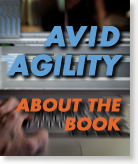As we move into NAB time (the show starts Saturday), it seems to me that the Apple/Avid competitive landscape has shifted significantly. Final Cut hasn’t delivered a major upgrade in two years and won’t have a booth in Vegas. But Avid has been busy modernizing their feature set and doing serious work on reliability and performance. Two years ago Final Cut seemed almost unbeatable, and many people were predicting the end of Avid. Today, things look a bit more balanced. I participated in John Flowers’ “That Post Show” podcast recently and the consensus of the participants was that Media Composer’s new “Advanced Media Architecture” (AMA) is a big win for Avid. (The show isn’t online yet. I’ll post a link here when it is.)
You can work with just about any Quicktime media in FCP, and you can do it without conversion. That used to look like an important advantage. But today, many file-based cameras don’t shoot in QT formats. You can usually convert (“rewrap”) your media to QT — but if your format is supported by AMA, MC doesn’t ask you to do any conversion at all. You just grab the media and start cutting. Avid’s Achilles heal, the fact that it forced you to convert everything to its native formats, has morphed into a big advantage. And, strange as it may seem, the fact that Final Cut is tied so strongly to Quicktime begins to look like a limitation.
MC 3.0 brought big performance and stability improvements that were long overdue. I was able to work for three months with version 3.05 and could count the number of crashes I had on one hand. Final Cut isn’t nearly that stable. Version 3.5 brought additional improvements. And MC still beats FCP hands down for precise and complex trimming, something that many long-form editors, myself included, can’t live without.
It would be foolish to assume that Apple has been standing still these last two years, and I expect we’ll hear more from them soon. But in the meantime, MC is looking better and better.



Recent Comments